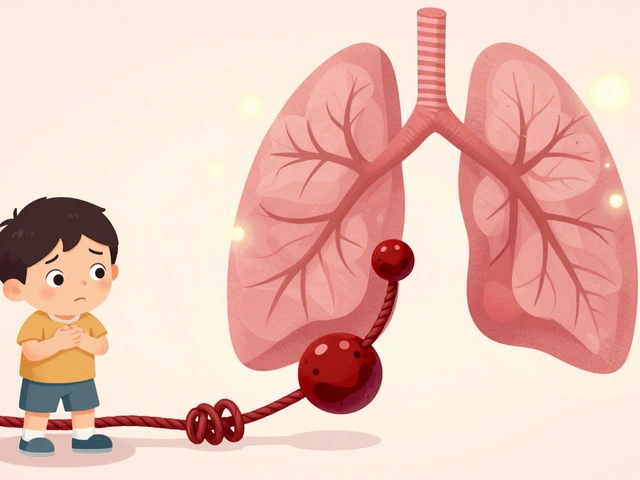TL;DR
- Helminth (worm) infections often suppress allergic reactions by shifting the immune system toward a regulatory state.
- The "hygiene hypothesis" suggests that reduced exposure to parasites in modern societies contributes to rising allergy rates.
- Key players include IgE antibodies, Th2 cytokines, eosinophils, and regulatory T cells.
- Anthelmintic treatment can sometimes trigger a rebound in allergy symptoms.
- Understanding this link opens doors to novel allergy therapies that mimic helminth‑derived molecules.
What the Helminth‑Allergy Connection Actually Is
Helminth‑Allergy Connection is a relationship where intestinal worm (helminth) infections modulate the body's allergic responses, often lowering the risk or severity of conditions like asthma and eczema.
When a person carries a worm, the parasite needs to stay alive for months or years. To avoid being expelled, it tricks the host’s immune system into tolerating it. This tolerance spills over into reduced reactivity to harmless allergens such as pollen or dust mite proteins.
Meet the Main Players
Helminths are parasitic worms-including roundworms, hookworms, and whipworms-that inhabit the human gastrointestinal tract. They account for over 1.5billion infections worldwide, with prevalence highest in tropical, low‑income regions.
Allergies are hypersensitive immune reactions to otherwise harmless substances (allergens). Common manifestations include allergic rhinitis, asthma, atopic dermatitis, and food allergies.
Immune System is the network of cells, tissues, and molecules that defends the body against pathogens while maintaining tolerance to self and non‑dangerous antigens.
Three immunological pathways dominate this discussion:
- Th2 response: Helminths and allergens both drive a Th2‑type response, producing cytokines like IL‑4, IL‑5, and IL‑13 that promote IgE production and eosinophil activation.
- Regulatory T cells (Tregs): Helminths strongly induce Tregs, which secrete IL‑10 and TGF‑β, dampening excessive inflammation.
- IgE antibodies: While IgE levels often rise in helminth infection, the antibodies tend to be directed at parasite antigens rather than environmental allergens.
The Hygiene Hypothesis in Action
Hygiene hypothesis proposes that reduced exposure to microbes and parasites in affluent societies skews the immune system toward allergic disease. Developed in the late 1980s, the theory gained traction when epidemiological surveys showed that children raised on farms-exposed to soil‑borne helminths-had up to 30% lower odds of asthma compared with urban peers.
Recent meta‑analyses of over 200 studies confirm a negative correlation between helminth prevalence and allergy rates, especially for atopic dermatitis and allergic rhinitis. The effect is strongest for chronic, low‑intensity infections rather than acute, high‑burden cases.
How Specific Worms Shape Allergic Outcomes
Not all helminths behave alike. Two of the most studied species are:
- Ascaris lumbricoides (large roundworm): Often linked to higher IgE levels and occasional wheezing, but in low‑dose infections it can suppress skin‑prick test reactivity.
- Necator americanus (hookworm): Strong inducer of Tregs and IL‑10, consistently associated with reduced asthma severity in controlled trials.
Understanding these nuances helps explain why some studies report a protective effect while others note a mild increase in allergic symptoms.

Comparison of Helminth Infection Versus No Infection
| Parameter | Helminth‑Infected | Helminth‑Free |
|---|---|---|
| IgE total level (kU/L) | ≈ 800±250 | ≈ 350±120 |
| Positive skin‑prick test rate | 22% | 48% |
| Asthma prevalence | 7% | 15% |
| Atopic dermatitis severity (SCORAD) | Mean 12 | Mean 23 |
| Regulatory T‑cell frequency (% CD4⁺) | 9.4% | 4.1% |
Data are drawn from longitudinal cohorts in Brazil, Kenya, and China, representing diverse genetic backgrounds and environmental conditions.
Implications for Allergy Treatment
Pharmaceutical interest has surged in "helminth‑derived immunomodulators"-molecules that mimic the parasite’s ability to promote tolerance without causing infection. Two candidates are in phase‑II trials:
- Acetyl‑CoA‑dependent protein kinase (AcKP) peptide: Shown to boost IL‑10 production in human peripheral blood mononuclear cells.
- ES‑62 glycoprotein: Derived from the filarial worm Acanthocheilonema vitae, reduces airway hyper‑responsiveness in mouse models.
Meanwhile, clinicians must be cautious when prescribing anthelmintic drugs (e.g., albendazole) to allergic patients. A sudden loss of helminth‑mediated regulation can provoke a transient flare of eczema or asthma, a phenomenon documented in post‑treatment surveillance studies.
Public‑Health Perspectives
From a population standpoint, the helminth‑allergy link presents a paradox. Eradicating parasites improves nutrition and reduces morbidity from anemia and growth stunting, yet it may inadvertently raise allergy prevalence. Policymakers therefore balance deworming campaigns with strategies that preserve immune regulation, such as probiotic supplementation or controlled exposure to benign microbial diversity.
Emerging programs in rural India combine mass deworming with soil‑based helminth‑like “micro‑biome” inoculations, reporting stable allergy rates while still cutting helminth‑related disease by 60%.
Related Concepts to Explore Next
Understanding the helminth‑allergy connection opens doors to several adjacent topics worth digging into:
- Microbiome‑Allergy Interactions: How gut bacteria shape IgE responses.
- Autoimmune Disease and Helminths: Similar regulatory mechanisms may protect against type‑1 diabetes and multiple sclerosis.
- Vaccination Strategies in Helminth‑Endemic Areas: How parasites influence vaccine efficacy.
- Environmental Exposure Therapy: Controlled exposure to allergens vs. controlled parasite exposure.
Each of these clusters adds depth to the broader picture of immune tolerance in the modern world.

Frequently Asked Questions
Do helminth infections cure allergies?
No. While chronic, low‑level helminth infections can lessen the intensity of allergic reactions, they do not eliminate the underlying sensitisation. The goal of research is to isolate the parasite’s immunoregulatory compounds, not to infect patients.
Which parasites have been studied for allergy modulation?
The most studied are Necator americanus (hookworm), Ascaris lumbricoides (roundworm), and filarial species like Onchocerca volvulus. Each shows a distinct pattern of cytokine induction and T‑cell regulation.
Can deworming increase my child’s risk of asthma?
Short‑term studies suggest a modest rise in asthma symptoms after mass deworming, especially in children who had long‑standing infections. Long‑term data are mixed; most health authorities still recommend deworming for its overall benefits.
What is the role of regulatory T cells in this process?
Regulatory T cells (Tregs) release anti‑inflammatory cytokines (IL‑10, TGF‑β) that suppress overactive Th2 responses. Helminths boost Treg frequency, creating a more tolerant immune environment that dampens allergic inflammation.
Are there any approved helminth‑derived allergy drugs?
Not yet. Several candidates are in clinical trials, but no helminth‑derived product has received regulatory approval as of 2025.
How does the gut microbiome intersect with worm‑induced immunity?
Worms reshape the microbial ecosystem, increasing short‑chain‑fatty‑acid‑producing bacteria that further stimulate Tregs. This three‑way interaction reinforces the anti‑allergic state.






6 Comments
The data from Brazil and Kenya is solid, but I’ve seen similar patterns in rural Punjab-kids with hookworms had way fewer eczema flare-ups. But here’s the kicker: when they got dewormed during public health drives, the asthma cases spiked for about 6 months. No one tracked it long-term, though.
Look, I’ve spent years in tropical clinics and I’ve seen this firsthand-helminths aren’t just parasites, they’re basically nature’s own immunomodulators. The fact that we’re now trying to bottle their magic instead of just accepting that maybe we’ve gone too sterile? That’s not science, that’s a cultural reckoning. We sanitized our way into a pandemic of allergies while ignoring the fact that our immune systems evolved to live with these organisms. It’s like removing the brakes from a car and then wondering why it keeps crashing. The real breakthrough isn’t just AcKP or ES-62-it’s accepting that human health isn’t about eradication, it’s about coexistence. We need to stop treating every microbe like an enemy and start seeing them as old, misunderstood allies.
I appreciate how clearly this was laid out. The table comparing infected vs. non-infected populations is especially helpful. It makes me wonder if we could design a kind of ‘immune reset’ protocol-maybe combining controlled microbial exposure with probiotics-instead of just jumping to drugs or deworming. There’s something gentle about working with the body’s natural rhythms rather than against them.
So let me get this straight-worms are good now? Next you’ll tell me smoking prevents Alzheimer’s. IgE levels are higher in infected people but you call that protective? That’s like saying a fire alarm going off all the time means your house is safer. And don’t even get me started on ‘helminth-derived immunomodulators’-sounds like a lab experiment that got lost in a sci-fi novel. Wake up, people. We don’t need to infect ourselves with parasites to fix what’s broken. We need better hygiene, better diets, less sugar. Not more worms.
This is one of those topics where the science is so nuanced it’s easy to misinterpret. I’ve read the papers on Tregs and IL-10 and the microbiome interactions-it’s not just about worms, it’s about the whole ecosystem of what we’re exposed to from birth. The fact that India is trying soil-based inoculations instead of just deworming? That’s brilliant. It’s not about going back to the past, it’s about learning from it. I’ve seen kids in my neighborhood with eczema improve after their parents started letting them play in dirt and eat unpeeled fruit. Not because of worms, but because their immune systems got the right kind of training. Maybe we need to think less about ‘treating’ allergies and more about ‘training’ immunity.
ALERT: Big Pharma is weaponizing helminth research to sell you a $20,000 biologic while hiding the fact that you can get the same effect by eating raw soil. The WHO and CDC have been suppressing data since 2012 because deworming programs are tied to vaccine contracts. ES-62? That’s just a front for a bioengineered allergen trigger. Look at the funding sources. Every single trial is backed by companies that sell asthma inhalers. They don’t want you to know that a $0.05 deworming pill might be all you need-because then you’d stop buying $300 monthly biologics. Wake up. The ‘hygiene hypothesis’ was invented by a guy who got paid by a parasite drug company. This isn’t science. It’s a cover-up.